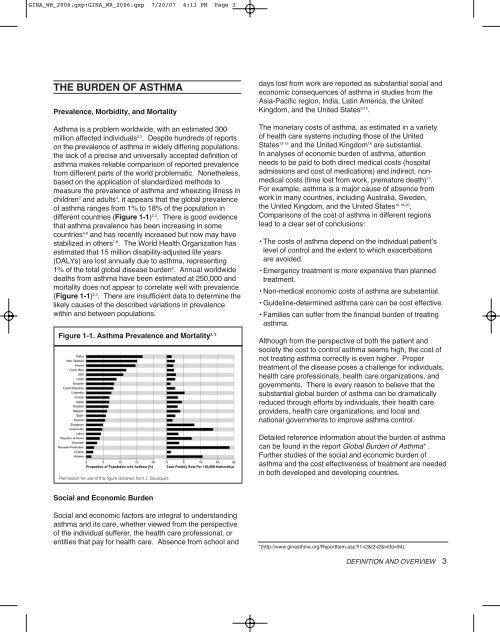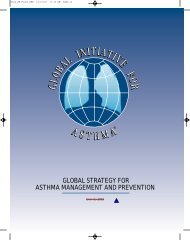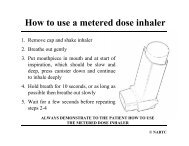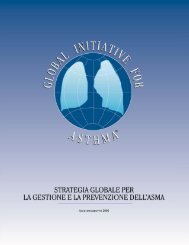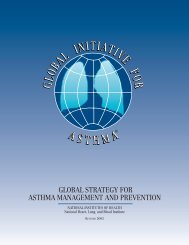global strategy for asthma management and prevention
global strategy for asthma management and prevention
global strategy for asthma management and prevention
You also want an ePaper? Increase the reach of your titles
YUMPU automatically turns print PDFs into web optimized ePapers that Google loves.
GINA_WR_2006.qxp:GINA_WR_2006.qxp 7/20/07 4:11 PM Page 3THE BURDEN OF ASTHMAPrevalence, Morbidity, <strong>and</strong> MortalityAsthma is a problem worldwide, with an estimated 300million affected individuals 2,3 . Despite hundreds of reportson the prevalence of <strong>asthma</strong> in widely differing populations,the lack of a precise <strong>and</strong> universally accepted definition of<strong>asthma</strong> makes reliable comparison of reported prevalencefrom different parts of the world problematic. Nonetheless,based on the application of st<strong>and</strong>ardized methods tomeasure the prevalence of <strong>asthma</strong> <strong>and</strong> wheezing illness inchildren 3 <strong>and</strong> adults 4 , it appears that the <strong>global</strong> prevalenceof <strong>asthma</strong> ranges from 1% to 18% of the population indifferent countries (Figure 1-1) 2,3 . There is good evidencethat <strong>asthma</strong> prevalence has been increasing in somecountries 4-6 <strong>and</strong> has recently increased but now may havestabilized in others 7,8 . The World Health Organization hasestimated that 15 million disability-adjusted life years(DALYs) are lost annually due to <strong>asthma</strong>, representing1% of the total <strong>global</strong> disease burden 2 . Annual worldwidedeaths from <strong>asthma</strong> have been estimated at 250,000 <strong>and</strong>mortality does not appear to correlate well with prevalence(Figure 1-1) 2,3 . There are insufficient data to determine thelikely causes of the described variations in prevalencewithin <strong>and</strong> between populations.Figure 1-1. Asthma Prevalence <strong>and</strong> Mortality 2, 3Permission <strong>for</strong> use of this figure obtained from J. Bousquet.days lost from work are reported as substantial social <strong>and</strong>economic consequences of <strong>asthma</strong> in studies from theAsia-Pacific region, India, Latin America, the UnitedKingdom, <strong>and</strong> the United States 9-12 .The monetary costs of <strong>asthma</strong>, as estimated in a varietyof health care systems including those of the UnitedStates 13-15 <strong>and</strong> the United Kingdom 16 are substantial.In analyses of economic burden of <strong>asthma</strong>, attentionneeds to be paid to both direct medical costs (hospitaladmissions <strong>and</strong> cost of medications) <strong>and</strong> indirect, nonmedicalcosts (time lost from work, premature death) 17 .For example, <strong>asthma</strong> is a major cause of absence fromwork in many countries, including Australia, Sweden,the United Kingdom, <strong>and</strong> the United States 16,18-20 .Comparisons of the cost of <strong>asthma</strong> in different regionslead to a clear set of conclusions:• The costs of <strong>asthma</strong> depend on the individual patientʼslevel of control <strong>and</strong> the extent to which exacerbationsare avoided.• Emergency treatment is more expensive than plannedtreatment.• Non-medical economic costs of <strong>asthma</strong> are substantial.• Guideline-determined <strong>asthma</strong> care can be cost effective.• Families can suffer from the financial burden of treating<strong>asthma</strong>.Although from the perspective of both the patient <strong>and</strong>society the cost to control <strong>asthma</strong> seems high, the cost ofnot treating <strong>asthma</strong> correctly is even higher. Propertreatment of the disease poses a challenge <strong>for</strong> individuals,health care professionals, health care organizations, <strong>and</strong>governments. There is every reason to believe that thesubstantial <strong>global</strong> burden of <strong>asthma</strong> can be dramaticallyreduced through ef<strong>for</strong>ts by individuals, their health careproviders, health care organizations, <strong>and</strong> local <strong>and</strong>national governments to improve <strong>asthma</strong> control.Detailed reference in<strong>for</strong>mation about the burden of <strong>asthma</strong>can be found in the report Global Burden of Asthma* .Further studies of the social <strong>and</strong> economic burden of<strong>asthma</strong> <strong>and</strong> the cost effectiveness of treatment are neededin both developed <strong>and</strong> developing countries.Social <strong>and</strong> Economic BurdenSocial <strong>and</strong> economic factors are integral to underst<strong>and</strong>ing<strong>asthma</strong> <strong>and</strong> its care, whether viewed from the perspectiveof the individual sufferer, the health care professional, orentities that pay <strong>for</strong> health care. Absence from school <strong>and</strong>*(http://www.gin<strong>asthma</strong>.org/ReportItem.asp?l1=2&l2=2&intId=94).DEFINITION AND OVERVIEW 3


